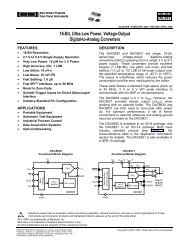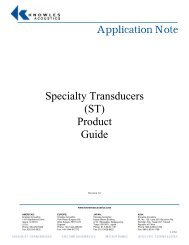AD7714* 3 V/5 V, CMOS, 500 µA Signal Conditioning ADC - dreamm
AD7714* 3 V/5 V, CMOS, 500 µA Signal Conditioning ADC - dreamm
AD7714* 3 V/5 V, CMOS, 500 µA Signal Conditioning ADC - dreamm
Create successful ePaper yourself
Turn your PDF publications into a flip-book with our unique Google optimized e-Paper software.
CIRCUIT DESCRIPTION<br />
The AD7714 is a sigma-delta A/D converter with on-chip digital<br />
filtering, intended for the measurement of wide dynamic<br />
range, low frequency signals such as those in weigh-scale, pressure<br />
transducer, industrial control or process control applications.<br />
It contains a sigma-delta (or charge-balancing) <strong>ADC</strong>, a<br />
calibration microcontroller with on-chip static RAM, a clock<br />
oscillator, a digital filter and a bidirectional serial communications<br />
port. The part consumes only <strong>500</strong> µA of power supply current<br />
and features a standby mode which requires only 10 µA,<br />
making it ideal for battery-powered or loop-powered instruments.<br />
The part comes in two versions, the AD7714-5 which is<br />
specified for operation from a nominal +5 V analog supply<br />
(AV DD ) and the AD7714-3 which is specified for operation from<br />
a nominal +3.3 V analog supply. Both versions can be operated<br />
with a digital supply (DV DD ) voltage of either +3.3 V or +5 V.<br />
The part contains three programmable-gain fully differential<br />
analog input channels which can be reconfigured as five pseudodifferential<br />
inputs. The gain range on all channels is from 1 to<br />
128 allowing the part to accept unipolar signals of between<br />
0 mV to +20 mV and 0 V to +2.5 V. In bipolar mode, the part<br />
handles genuine bipolar signals of ±20 mV and quasi-bipolar<br />
signals up to ±2.5 V when the reference input voltage equals<br />
+2.5 V. With a reference voltage of +1.25 V, the input ranges<br />
are from 0 mV to +10 mV to 0 V to +1.25 V in unipolar mode<br />
while in bipolar mode, the part handles genuine bipolar signals<br />
of ±10 mV and quasi-bipolar signals up to ±1.25 V.<br />
The part employs a sigma-delta conversion technique to realize<br />
up to 24 bits of no missing codes performance. The sigmadelta<br />
modulator converts the sampled input signal into a digital<br />
pulse train whose duty cycle contains the digital information.<br />
AD7714<br />
The programmable gain function on the analog input is also<br />
incorporated in this sigma-delta modulator with the input sampling<br />
frequency of the modulator being modified to give the<br />
higher gains. A sinc 3 digital low-pass filter processes the output<br />
of the sigma-delta modulator and updates the output register at<br />
a rate determined by the first notch frequency of this filter. The<br />
output data can be read from the serial port randomly or periodically<br />
at any rate up to the output register update rate. The<br />
first notch of this digital filter, its –3 dB frequency and its output<br />
rate can be programmed via the filter high and filter low<br />
registers. With a master clock frequency of 2.4576 MHz, the<br />
programmable range for this first notch frequency and output<br />
rate is from 4.8 Hz to 1.01 kHz giving a programmable range<br />
for the –3 dB frequency of 1.26 Hz to 265 Hz.<br />
The basic connection diagram for the part is shown in Figure 2.<br />
This shows both the AV DD and DV DD pins of the AD7714 being<br />
driven from the analog +3 V or +5 V supply. Some applications<br />
will have AV DD and DV DD driven from separate supplies. In the<br />
connection diagram shown, the AD7714’s analog inputs are<br />
configured as three fully differential inputs. The part is set up<br />
for unbuffered mode on the these analog inputs. An AD780,<br />
precision +2.5 V reference, provides the reference source for the<br />
part. On the digital side, the part is configured for three-wire<br />
operation with CS tied to DGND. A quartz crystal or ceramic<br />
resonator provides the master clock source for the part. It may<br />
be necessary to connect capacitors on the crystal or resonator to<br />
ensure that it does not oscillate at overtones of its fundamental<br />
operating frequency. The values of capacitors will vary depending<br />
on the manufacturer’s specifications.<br />
2<br />
ANALOG<br />
+5V<br />
SUPPLY<br />
10µF<br />
0.1µF<br />
0.1µF<br />
ANALOG<br />
+5V<br />
SUPPLY<br />
DIFFERENTIAL<br />
ANALOG INPUT 1<br />
DIFFERENTIAL<br />
ANALOG INPUT 2<br />
DIFFERENTIAL<br />
ANALOG INPUT 3<br />
VIN<br />
ANALOG<br />
GROUND<br />
DIGITAL<br />
GROUND<br />
AV DD DV DD<br />
AIN1 DRDY<br />
AIN2<br />
CS<br />
AIN3<br />
AIN4<br />
DOUT<br />
AIN5 DIN<br />
AIN6<br />
SCLK<br />
AD7714<br />
AGND RESET<br />
SYNC<br />
DGND<br />
STANDBY<br />
DATA<br />
READY<br />
RECEIVE<br />
(READ)<br />
SERIAL<br />
DATA<br />
SERIAL<br />
CLOCK<br />
+5V<br />
VOUT<br />
AD780<br />
GND<br />
10µF<br />
0.1µF<br />
REF IN(+) POL<br />
MCLK IN<br />
REF IN(–)<br />
MCLK OUT<br />
BUFFER<br />
CRYSTAL OR<br />
CERAMIC<br />
RESONATOR<br />
Figure 2. Basic Connection Diagram<br />
REV. B –17–















